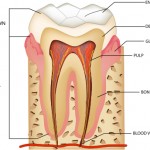
Accurate diagnosis of the condition of the dental pulp has an important bearing on treatment planning. The aim of this review was to appraise the diagnostic accuracy of signs/symptoms and tests used to determine the condition of the pulp in teeth affected by deep caries, trauma or other types of injury.
The authors searched PubMed, Embase, The Cochrane Central Register of Controlled Trials and Cochrane Reviews. Hand searching of the references of narrative reviews, text books and articles in international journals not identified in the main search was also caried out. Cross-sectional, case–control and prospective cohort studies designs were included where the reference test was either: Histological examination of the extracted tooth or extirpated pulp tissue or the inspecting/probing the exposed pulp tissue for adult teeth . For immature teeth: radiographic examination combined with observing continued root development.
Two reviewers independently assessed abstracts and full-text articles. The quality of included articles was assessed using the QUADAS (Quality Assessment of Diagnostic Accuracy Studies ) tool with the the quality of evidence of each diagnostic method/test being rated in four levels according to GRADE criteria.
They found that:-
18 studies met the pre-specified inclusion criteria. Two were rated a moderate quality and 16 of low quality using the GRADE criteria.
The overall evidence was insufficient to assess the value of toothache or abnormal reaction to heat/cold stimulation for determining the pulp condition. The same applies to methods for establishing pulp status, including electric or thermal pulp testing, or methods for measuring pulpal blood circulation.
The authors concluded:-
The scientific evidence is insufficient to assess the accuracy of the following clinical signs, symptoms or tests used to determine the condition of pulp:
- hypersensibility to heat, response to cold, electric stimulation or tenderness to percussion in asymptomatic teeth with deep caries lesions,
- presence, character or duration of pain and
- in terms of reversible/irreversible pulp inflammation.
The evidence base is also insufficient to assess the accuracy of the following:
- combining tests to determine the condition of pulp,
- electrical or thermal pulp testing or methods for measuring pulpal blood circulation to determine whether the pulp is vital or nonvital and
- biological markers of pulp inflammation, infection or other tissue damage for predicting the outcome of treatment intended to maintain an exposed pulp vital and asymptomatic.
Mejàre, I. A., Axelsson, S., Davidson, T., Frisk, F., Hakeberg, M., Kvist, T., Norlund, A., Petersson, A., Portenier, I., Sandberg, H., Tranæus, S. and Bergenholtz, G. (2012), Diagnosis of the condition of the dental pulp: a systematic review. International Endodontic Journal. doi: 10.1111/j.1365-2591.2012.02016.x
Comment
This is a well-conducted review which highlights major shortcomings in studies conducted in this area. While the papers discussion notes some reasons why research in the area may be challenging it also notes that both the conduct and reporting of studies in this area needs to follow well developed guidelines such as those found in Standards for Reporting of Diagnostic Accuracy (STARD).
